Permanent Local Rules
1. OUT OF BOUNDS
a) The area of the clubhouse and car park, including the patio and adjacent cultivated borders. On the terrace the boundary is defined by the course-side edge of the patio.
b) Stockbridge pond to the left of the 2nd hole as defined by white posts.
c) The reservoir behind the 17th green as defined by the fence and the maintenance area (‘middle yard’) to the right of the 5th and 18th holes as defined by white posts.
2. ROADS, PATHS & TRACKS
All rubber bark paths and paths which have a wooden edging are treated as Immovable Obstructions and relief is available under Rule 16.1. All other paths and tracks on the course are Integral Objects from which no free relief is available under Rule 16.1.
Note:
Some wooden edging to paths may be damaged or partially covered by sand/soil or grass. However, as long as it is clear that the path had been wooden edged during construction, relief is available.
Where a wooden edged path joins another path without edging, the border is determined by the line between the points where the wooden edging terminates.
3. FIXED SPRINKLER HEADS CLOSE TO PUTTING GREEN
All fixed sprinkler heads are immovable obstructions. In addition, if a ball lies off the putting green, not in a bunker or penalty area, and an immovable obstruction on or within two club lengths of the putting green and within two club-lengths of the ball, intervenes on the line of play between the ball and the hole, the player may take relief (Rule 16.1b). Note: Under Rule 16.1a relief is also available when the ball is on the green and the sprinkler head is on or off the green and on the line of play, regardless of the distance between the ball and the obstruction.
4. GROUND UNDER REPAIR
Ground under repair is defined by any area encircled by a white line or small blue and white posts.
Note:
Stakes: When defined by stakes, the edge of the ground under repair is defined by the line between the outside points of the stakes at ground level, and the stakes are inside the ground under repair.
Dropping Zones: When these are marked for a specific area and the player's ball is in the ground under repair, including when it is known or virtually certain that a ball that has not been found is in the ground under repair, the player has these relief options:
The player may take relief under Rule 16.1, or
As an extra option, the player may take free relief by dropping the original ball or another ball in the dropping zone. The dropping zone is a relief area under Rule 14.3.
Penalty for Playing Ball from a Wrong Place in Breach of Local Rule: General Penalty Under Rule 14.7a.
5. SAND WASTE AREAS
The prepared areas of sand on the 2nd hole (the first two areas), in front of the 3rd tee and to the left of 4th hole, are part of the general area and not bunkers. Nb. - 2nd Hole - For clarity, there are four sand areas on the 2nd hole, the area short of the bridle path and the area just beyond the path are waste areas, the two areas nearest the green, (front and right) are bunkers.
6. SEAMS OF CUT TURF
If a player's ball lies in or touches a seam of cut turf* or a seam interferes with the player's area of intended swing:
(a) Ball in General Area. The player may take relief under Rule 16.1b.
(b) Ball on Putting Green. The player may take relief under Rule 16.1d.
But interference does not exist if the seam only interferes with the player's stance.
All seams within the area of cut turf are treated as the same seam in taking relief. This means that if a player has interference from any seam after dropping the ball, the player must proceed as required under Rule 14.3c(2) even when the ball is still within one club-length of the reference point.
(This means that you may take free relief for interference from a seam when it interferes with your lie or area of intended swing. If you drop the ball and still have interference from the same seam OR ANOTHER SEAM you drop again in the same place as the original drop.)
Penalty for Playing Ball from a Wrong Place in Breach of Local Rule: General Penalty Under Rule 14.7a.
*Note: Cut turf includes heather slabs.
7. AERATION HOLES
If a player's ball lies in or touches an aeration hole:
(a) Ball in General Area. The player may take relief under Rule 16.1b. If the ball comes to rest in another aeration hole the player may take relief again under this Local Rule.
(b) Ball on Putting Green. The player may take relief under Rule 16.1d.
But interference does not exist if the aeration hole only interferes with the player's stance or area of intended swing or, on the putting green, on the player's line of play.
Penalty for Playing Ball from a Wrong Place in Breach of Local Rule: General Penalty Under Rule 14.7a.



